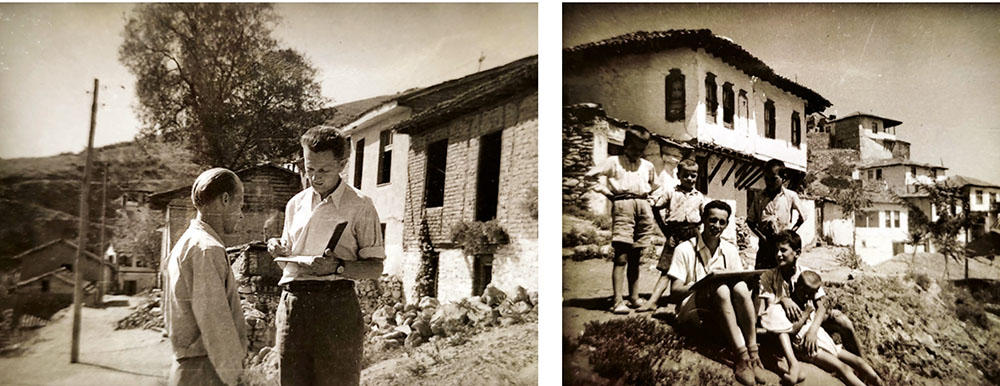Fieldwork and its Influence towards a complex Modernism
Downloads
DOI:
https://doi.org/10.52200/docomomo.72.06Keywords:
Macedonian House, Spatiality (spatio-plasticity), Porch - čardak (veranda), House for Everyone, vernacularAbstract
Grabrijan sought to explain and affirm a coexistence of the modern and the traditional in architecture, especially in his seminal studies of Bosnian architecture and the Macedonian house. Co-authored with Neidhardt, his publication about Bosnian architecture is well-known and studied. Grabrijan’s posthumous publication, The Macedonian House, based on the data collected during his fieldwork in regional towns in Macedonia (1946, 1947, 1949), serves to punctuate the progressive modernizing forces and their focus on reconstruction, urbanization, and speedy industrialization of major centers as well as peripheral areas, in the Socialist Republic of (SRMacedonia), as elsewhere in Yugoslavia. As an archival record, The Macedonian House presents a different focus and a rebalance of the postwar agenda that had eclipsed small towns from architectural interest and had effectively produced the demise of the vernacular traditions in the towns. With an ideology to learn from the architecture of the people, Grabrijan’s work wove the vernacular back into a more complex modernism.
Grabrijan first traveled to S.R. Macedonia in the summer of 1946 as part of a Yugoslavia-wide exchange–solidarity assistance for post-war renewal. He then organized two research journeys in 1947 and 1949, taking a group of students for fieldwork training. In his archives containing the documents and fieldwork for the publication about the Macedonian House, a drawing of a map of the Balkans resonates with the map of Le Corbusier’s 1911 formative journey to the East, including a coded notation which may refer to folklore, culture, and industry. Grabrijan’s enthusiasm for studying the traditional houses in Macedonia takes him to small towns, covering a broad geography of spatial dialects. Drawing from the Grabrijan archives, this paper will explore his fieldwork methods and his modalities of researching the complex conditions from which the “house for everyone” rises above the ground.
How to Cite
Published
Issue
Section
License
Copyright (c) 2024 Mirjana Lozanovska, Viktorija Bogdanova

This work is licensed under a Creative Commons Attribution 4.0 International License.
Plaudit
References
ALIĆ, D. (2015). Vision of a Nation: From Dušan Grabrijan’s Notes on Plečnik and His School. In Centropa: A Journal of Central European Architecture and Related Arts, 15(1), pp. 86-90.
BLAGOJEVIĆ, L. (2013). The post-modernist turn and spectres of criticality in post-socialist architecture: ‘one:table’ at the Venice Biennale 2012. In The Journal of Architecture, 18(6), pp. 761-780. https://dx.doi.org/10.1080/13602365.2013.857707 DOI: https://doi.org/10.1080/13602365.2013.857707
ČELIĆ, D. (1970). Grabrijan i Sarajevo: Izabrani članci 1936-42 [Grabrijan and Sarajevo: Selected articles 1936-42]. Muzej grada Sarajeva, Sarajevo.
GRABRIJAN, D. (1959). Kako je nastajala naša sodobna hiša? [How Has Our Contemporary House Come Into Being]. Mladinjska knjiga, Ljubljana.
ГРАБРИЈАН, Душан. (1955). Македонска куќа: или преод од стара ориенталска во современа европска куќа [GRABRIJAN, Dušan, Makedonska kukja: ili preod od stara orientalska vo sovremena evropska kukja / Macedonian House: Transition from Old Oriental to Contemporary European House], Državna založba Slovenije, Ljubljana (in Macedonian).
ГРАБРИЈАН, Душан. (1986). Македонска куќа: или преод од стара ориенталска во современа европска куќа [GRABRIJAN, Dušan, Makedonska kukja: ili preod od stara orientalska vo sovremena evropska kukja / Macedonian House: Transition from Old Oriental to Contemporary European House], Misla, Skopje (in Macedonian).
GRABRIJAN, D. (1976). Makedonska hiša: ali prehod iz stare orientalske v sodobno evropsko hišo [Macedonian House: Transition from Old Oriental to Contemporary European House]. Partizanska knjiga, enota Znanstevni tisk, Ljublljana.
GRABRIJAN, D. & Neidhardt, J. (1957). Arhitekura Bosne i put u suvremeno [Bosnian Architecture And The Path to Modernity]. Državna založba Slovenije, Ljublljana.
GRABRIJAN, D. (1961). Zgodovina arhitekture 1, prosto po Choisy-ju [History of Architecture 1, according to Choisy]. Univerza v Ljubljani, Fakulteta za arhitekturo, gradbeništvo in geodezijo, Univerzitetna založba, Ljubljana.
KULIĆ, V., Mrduljaš, M., & Thaler, W. (2012). Modernism in-Between: The Mediatory Architectures of Socialist Yugoslavia. Jovis Verlag, Berlin.
LE CORBUSIER. (1966|2007). Journey to the East (I. Zaknic, Trans.). MIT Press, Cambridge. (Original work published by Forces Vives (Paris) in 1966 under the title Le Voyage d’Orient).
LOZANOVSKA, M. & Boshkova, D. (2015). The ‘Ohrid School’—Critical Regionalism in Socialist Macedonia? In V. Djokić, A. Nikezić, & A. Raković (Eds.), Proceedings of the 2015 International Scientific Thematic Conference on Entangled Histories, Multiple Geographies (pp. 291-297). EAHN, University of Belgrade, Faculty of Architecture, Belgrade.
LOZANOVSKA, M. (2015). Brutalism, Metabolism and Its American Parallel. In Fabrications: The Journal of the Society of Architectural Historians, Australia and New Zealand, 25(2), Routledge, pp. 152-175. https://dx.doi.org/10.1080/10331867.2015.1032482 DOI: https://doi.org/10.1080/10331867.2015.1032482
LOZANOVSKA, M. & Popescu, C. (2023). Different Priorities: Yugoslavian and Romanian Architects in and out. In G. Hartoonian (Ed.), The Visibillity of Modernization in Architecture: A Debate (pp. 94-117). Routledge. DOI: https://doi.org/10.4324/9781003257776-9
POPESCU, C. (2019). Flattening History: A Prequel to the Invention of Critical Regionalism. In Critical Regionalism Revisited, OASE (103). nai010 publishers, Rotterdam, pp. 49-53.
POZZETTO, M. (1996). Plečnikova šola v Ljubljani. In Jože Plečnik: arhitektura za novo demokracijo [Jože Plečnik: architecture for a new democracy]. A catalogue of an exhibition in Prague, Arhitekturni muzej, Ljubljana, pp. 7-29, 81-94.
ROTAR, B. (1990). Dušan Grabrijan: arhitekt, pedagog, raziskovalec in pisec [Dušan Grabrijan: Architect, Pedagogue, Researcher and Writer]. [Unpublished diploma thesis, University of Ljubljana, Faculty of Philosophy, Department of History of Arts].
ZUPANČIČ, B. (2017). Plečnikovi študenti in drugi jugoslovanski arhitekti v Le Corbusierovem ateljeu [Plečnik’s Students And Other Yugoslav Architects in Le Corbusier’s Atelier]. Muzej za arhitekturo in oblikovanje (MAO) and KUD Polis, Ljubljana.





